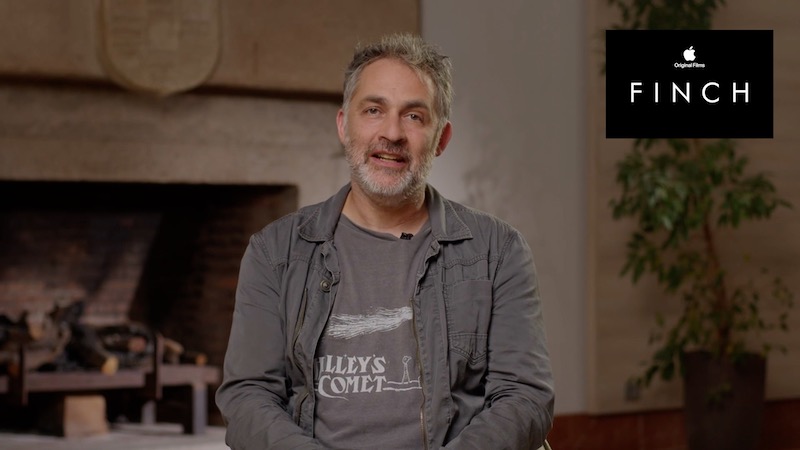Tom Hanks’ latest film Finch releases on Apple TV+ on Friday, November 5. The movie is directed by Miguel Sapochnik, who has received critical acclaim for his work on Game of Thrones and True Detective.
“In the film, a man, a robot, and a dog form an unlikely family in a powerful and moving adventure of one man’s quest to ensure that his beloved canine companion will be cared for after he’s gone,” reads the official synopsis. “Hanks stars as Finch, a robotics engineer and one of the few survivors of a cataclysmic solar event that has left the world a wasteland. But Finch, who has been living in an underground bunker for a decade, has built a world of his own that he shares with his dog, Goodyear. He creates a robot to watch over Goodyear when he no longer can.”
ComingSoon Editor-in-Chief Tyler Treese spoke with Finch director Miguel Sapochnik about the film, its interesting blend of genres, and working with a lovely rescue dog.
Tyler Treese: Miguel, you received such critical acclaim for your work on TV since Repo Men. What’s the biggest lesson you’ve learned during this time that you managed to apply in Finch?
Miguel Sapochnik: I think one of the most surprising things that I’ve learned is that confidence actually makes you a better director because as you learn and you understand what works and what doesn’t work and your confidence grows in your craft, you’re able to make decisions faster and more effectively with a better understanding of the repercussions and the consequences of those decisions. So feeling confident has a much larger impact on my ability to direct than I thought it would.
Animals can be difficult to work with sometimes, but the dog is so emotive and adds such a great dynamic to the film. Can you talk about working with the dog and just how much it adds to the film?
It was actually a very, very easy process working with the dog. Seamus is a rescue dog that we picked and then introduced to Tom Hanks who had an instant rapport with him. And so he was really trained to be a dog. We tried to avoid giving him any special tricks. But the idea was if we could not anthropomorphize this dog but allow the dog to just exist in the space, hopefully his personality, which was one of general nonchalance, would emerge and we would start to see a real relationship between a man and dog, or robot and dog in this case. And I think we kind of tried to hold really strongly to that and avoid adding too much to the dog’s behavior.
That said, you’d put the camera on the dog and the dog would generally be uninterested in anything that we were doing. And then you’d put the camera on the dog and the dog would suddenly start doing all of these special moves. And it was kind of fascinating to watch because I don’t know where that came from. There were other days where we’d put the camera on the dog and the dog would literally do nothing you asked him to do and wander off or eat sticks in the middle of other people’s scene so you couldn’t hear anything properly and the dialogue wouldn’t come through, but we realized soon that the dog’s relationship was not necessarily with us, but with his trainer.
So when he had a good day with his trainer, he would do everything. And when he had a bad day with the trainer, he would become this disobedient dog. You would see this really interesting love affair between the dog and his trainer that was very reminiscent of the kind of relationship we were trying to create between Finch and Goodyear.
The film goes in so many different directions. There’s almost like a buddy comedy and road trip aspect to it at some points, and it’s able to blend so many serious topics with some comedy. It’s very versatile. How was it blending those genres and could you speak to Tom Hanks’ versatility?
Comedy is a forte of his and he’s able to do very serious dramas. I think we spent a lot of time talking about the darker side of Finch, this guy who had basically had a really bad experience with humanity and felt very hard done by and we also were seeking to take that character, but not necessarily overtly explain his dark side, but rather have it exist in the background. It was an underbelly which comes out in particular in a scene later in the film where Finch has a confession to Jeff about how he found Goodyear.
The nature of how you blend the genres is you cross your fingers and hope that it works. I’ve always been a huge fan of genre-bending movies. I find them thoroughly entertaining. I love seeing things that mix different genres. I know that it’s a very dangerous thing to do because you can fail magnificently at all of them. I’ve had my experience of doing that. But for me, I like something that makes me laugh and cry and be scared and fight and get my adrenaline going. I really enjoy that kind of movie-making. It’s a kind of a generalist movie making that makes me want to go to the cinema.










